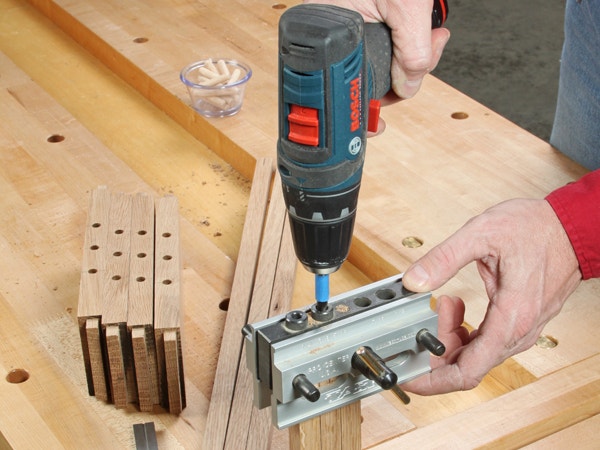How Should I Reinforce a Long Table Top Panel?
I would like to build a table to store an antique cabinet. The table will be 30" wide and 10 feet long. I have three boards for the top of the table. They are white oak and are 3/4 boards planed smooth. My plans are as follows: Connect the boards with glue and also dowels every 6 or 8 inches, and then plane the panel smooth. I will also connect the boards on the bottom with 1" wide oak strips, to assure they do not separate.
The tabletop will sit on six legs, tied together in groups of two; then all six boards tied together. The top will sit on the six legs and not be fastened securely, but with metal clips so the tabletop can move somewhat side to side.
What is the best way to glue the top boards together? Are the dowels needed, or would biscuits be better? Do I need the 1" wide boards fastened under the top three boards for added strength so they don't separate? - Warren Kirk
Tim Inman: This is a question that really stretches my abstract thinking cells. My vision of your table based on your description may be quite different than your vision, I'm afraid. So, let me just address some of your construction issues. First, this will be a huge, heavy table. Dowels are usually my last choice for joining. They do not add much strength and are generally a pain to handle. I much prefer biscuits because not only will they help align the edges at least as well as dowels will, but they also offer much more strength to the glue line than dowels can. Unless your wood is not flat, I would think a frequency of 6 to 8 inches would be overkill - by a factor of three. Finally, because of the way wood works, fastening a batten board going cross grain will only help to destroy the integrity of your joinery after a period of time. In other words, they will not prevent the wood from separating, they will cause it.

Chris Marshall: Dowels would be a tricky proposition on a tabletop glue-up as long as yours will be, Warren. If you go that route, be sure to use a clamp-on style doweling jig. The dowels have to be perfectly aligned across the joint so the boards will come together correctly with their faces flush, and a jig like this will make sure of it. If you try to just lay them out and drill the holes without a good jig, you'll regret it – especially over a 10-ft. length. At least a few will be mismatched, and those will prevent alignment of all of them rather than assisting it.
Biscuits definitely offer more forgiveness, because the slots are slightly longer than necessary. You'd have some wiggle room. Normally, I don't use any alignment aids for edge-gluing panels, but on a table as long as yours will be, I'd go with biscuits. And you'll need LOTS of pipe or bar clamps, so round those up ahead of time.
I'd skip the battens underneath for the reason Tim suggests. The glue joints will be strong enough to hold the boards together. The bigger issue is keeping the panel flat across and along its faces. I'd probably design my table with conventional aprons between the legs, then attach the tabletop to the aprons with shop-made wood buttons. The tongues of these fit into grooves in the aprons. They can allow for cross-grain wood movement, provided the grooves are deep enough and the tongues don't bottom out in the grooves seasonally.
Good luck with your table!
Keep the inspiration coming!
Subscribe to our newsletter for more woodworking tips and tricks




